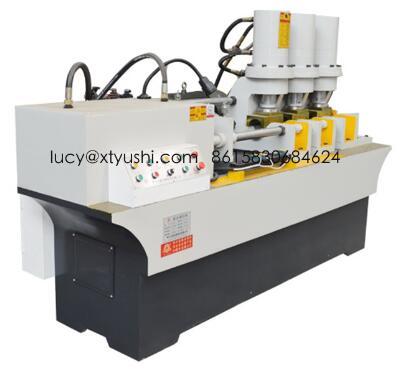A diameter reducing machine is an essential piece of equipment widely used in industries such as construction, automotive, aerospace, and metalworking to reduce the diameter of metal rods, pipes, and other cylindrical workpieces. By applying consistent pressure and advanced mechanical processes, this machine ensures high precision and efficiency, making it a cornerstone for manufacturers seeking to meet strict quality standards. In this article, we will explore the core principles, applications, and advantages of diameter reducing machines, with insights into their role in modern manufacturing.

Principle of Operation
The core function of a diameter reducing machine is to compress or reshape metal workpieces into a smaller diameter while maintaining their structural integrity. Unlike traditional cutting methods that result in material wastage, this machine utilizes a non-cutting process, typically cold-forming, to achieve the desired results.
The process generally involves the following steps:
- Feeding the Material: The workpiece, such as a metal rod or tube, is fed into the machine.
- Die Adjustment: Precision-engineered dies are used to compress the material to the required diameter.
- Cold-Forming: By applying uniform pressure, the machine reduces the diameter without affecting the material’s strength or surface quality.
- Final Output: The workpiece emerges with a uniform reduced diameter, ready for further processing or assembly.
Applications of Diameter Reducing Machines
Diameter reducing machines are indispensable across various industries due to their versatility and reliability. Common applications include:
- Automotive Industry: Used in the production of axles, suspension rods, and other components requiring precise diameters to ensure safe and efficient vehicle performance.
- Construction Sector: Plays a vital role in fabricating steel rods, rebars, and pipes for structural frameworks, ensuring they meet the required specifications for strength and durability.
- Aerospace Industry: Produces lightweight yet durable components such as landing gear rods and tubular sections for aircraft, where precision and quality are paramount.
- Metalworking and Tooling: Used for creating custom-sized rods, fasteners, and fittings essential for various industrial applications.
- Furniture Manufacturing: Reduces the diameter of metal tubes used in furniture frames, ensuring aesthetic appeal and uniformity in design.
Key Features and Advantages
A high-quality diameter reducing machine offers several advantages that make it a preferred choice for manufacturers:
- Precision and Consistency: These machines are designed to achieve tight tolerances, ensuring uniformity in the reduced diameter across large production runs.
- High Efficiency: Modern machines are equipped with advanced automation features, enabling faster production cycles and reducing manual intervention.
- Material Integrity: Since the process is non-cutting, the structural integrity of the material is preserved, resulting in stronger and more durable finished products.
- Cost-Effectiveness: By minimizing material wastage and reducing labor costs, diameter reducing machines offer excellent value for money, particularly in large-scale manufacturing.
- Customizability: Machines can be configured to handle a wide range of materials and diameters, making them versatile tools for diverse applications.
- Eco-Friendly Operation: The cold-forming process used by these machines is energy-efficient and generates minimal waste, aligning with the growing demand for sustainable manufacturing practices.
Choosing the Right Diameter Reducing Machine
Selecting the right machine for your needs requires careful consideration of several factors:
- Material Compatibility: Ensure the machine can handle the specific materials you work with, whether it’s carbon steel, stainless steel, aluminum, or other alloys.
- Capacity and Size Range: Choose a machine that supports the diameter range and production volume required for your operations.
- Automation Features: Look for machines with advanced automation options, such as CNC controls, to enhance efficiency and precision.
- Durability and Maintenance: Opt for machines built with high-quality components and designed for minimal maintenance to ensure long-term reliability.
- After-Sales Support: Reliable customer service, including installation, training, and spare parts availability, is crucial for uninterrupted operations.
At JUSHI, we provide cutting-edge diameter reducing machines designed to meet the diverse needs of modern manufacturers. Our machines are equipped with advanced features that ensure superior performance, precision, and efficiency.
Industry Trends and Market Demand
The global market for metalworking machinery, including diameter reducing machines, is experiencing steady growth. Factors such as increased demand for lightweight materials in automotive and aerospace industries, infrastructure development, and advancements in manufacturing technologies are driving this trend. According to industry reports, the metal forming tools market is projected to grow at a compound annual growth rate (CAGR) of over 5% between 2023 and 2030, highlighting the increasing adoption of advanced machinery.
For manufacturers aiming to stay competitive in today’s fast-paced market, investing in a high-performance diameter reducing machine is a strategic move. With over a decade of experience, JUSHI continues to lead the industry by providing innovative solutions that cater to the evolving demands of global manufacturers.







